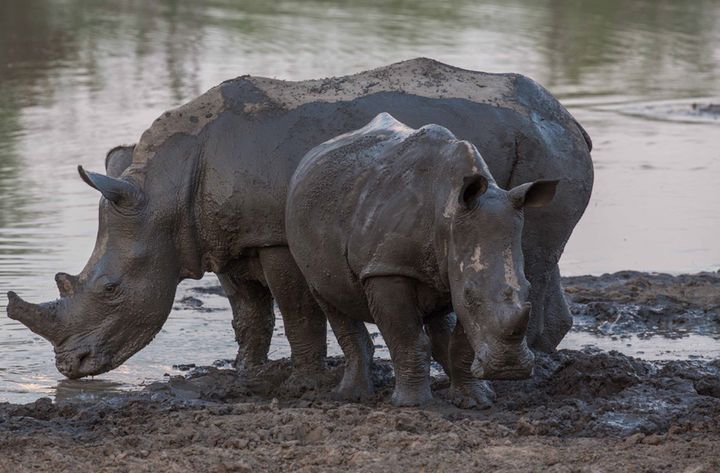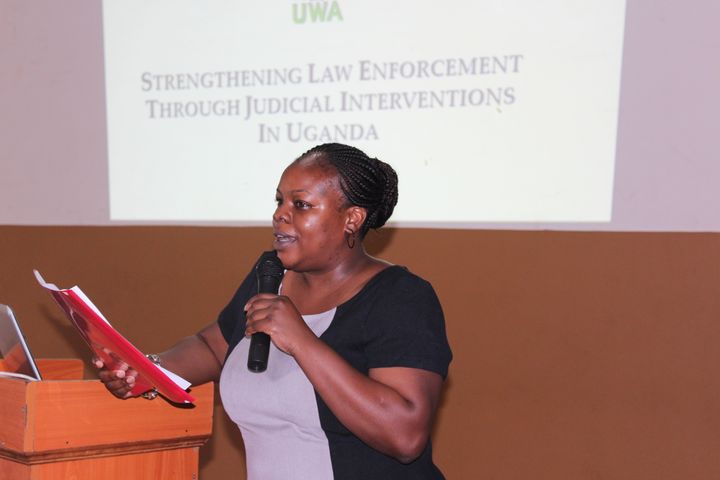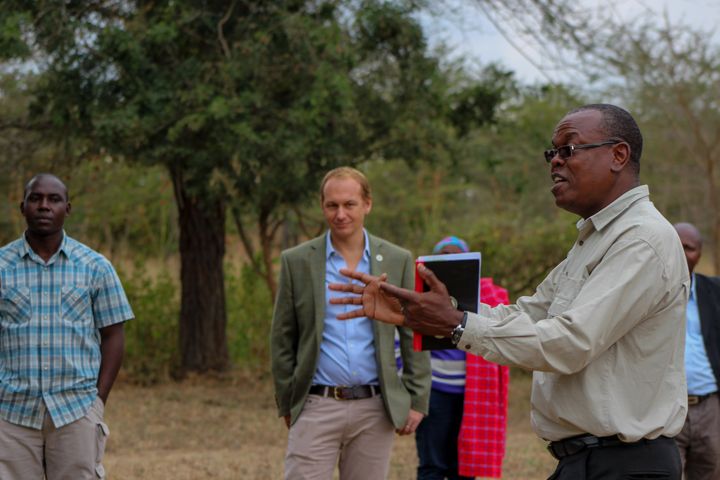
Two white rhinos by watering hole. Photo by permission, AWF.

Didi Wamukoya, legal expert trained in prosecuting wildlife cases, trains other members of law enforcement to ensure trafficking prosecutions.
See parts 1 and 2 of this story for a bigger picture of conservation efforts to save rhinos and other threatened African species.
Closing the loop
African Wildlife Foundation Chief Science Officer Dr. Phillip Muruthi has been involved with every link in the chain of illegal wildlife trafficking, which has decimated iconic African wildlife over the past decade. As part of his educational mission, Muruthi takes every opportunity to impress on authorities that loss of key wildlife will lead to systemic, economic degradation.
Dr. Muruthi acknowledges many weak links in the chain, especially where law enforcement does not always take wildlife crime seriously. While working to push wildlife crime up in priority, he also works to shore up whatever legal frameworks are currently in place.
“Many [criminal poaching] cases fail in court because prosecution did not do due diligence,” Muruthi says.
This means wildlife criminals, apprehended at the cost of so many resources, are often just walking away.
“So we train investigators: ‘Which laws did you use?’ We have hired a prosecutor [Didi Wamukoya]. She’s been trained in prosecuting [wildlife cases].”
With Wamukoya on board, Muruthi and AWF can play to one of their strengths: education and training programs. They have launched a four-day training course aimed at prosecutors and other key members of wildlife law enforcement.
Wamukoya gives trainees a rundown of the laws relevant to wildlife trafficking and conviction. Based on her court experience, she is also able to coach justice professionals in effective prosecution strategies.
The team drew expert support from professionals all over the world as they developed the framework for the course. They continue to draw on experts in wildlife crime to support ongoing workshops.
“It is very important to bring in the other agencies,” Muruthi says. “We’ve worked with Interpol [the International Criminal Police Organization]. We are also bringing in expertise from United States, the American College of Environmental Lawyers [ACOEL]. “
According to Muruthi, the program has already proven effective.
The program is scalable and replicable. The tools it passes on can fan out across the fractured poaching landscape, where solid criminal wildlife convictions will bolster other committed efforts on the ground. This AWF program culminates years of commitment and persistence in wrestling fluid crime syndicates, and it may not have come about without a certain organizational agility, a tendency to seize on solutions rather than dwell on problems.
“This is not traditional wildlife conservation,” Muruthi admits.
But a decade ago, neither was training sniffer dogs for airports.
It takes a village to save a rhino – the good news
Dr. Muruthi’s work is not all poachers, traffickers, and security trainees. As video on their homepage evidences, AWF is on a mission to be part of a thriving future Africa. That future, they contend, lives in a sustainable place where wildlife, humans, and habitats flow together in a tide that raises all boats.
“In the short term we want to cut [illegal wildlife] traffic,” Muruthi explains. “But why do you want to cut traffic? In the long term, I don’t think we will have sustainable development in Africa if we don’t conserve our species, our wildlife, and our wild lands.”
All over Africa, innovators are helping to manifest this vision. Two next-generation sustainability initiatives African Wildlife Foundation has its sights on are community-owned conservancies and eco-tourism. Namibia’s Grootberg Lodge is a great example of both – a community owned conservancy that earns income from tourists enjoying wildlife. The success of Grootberg Lodge has allowed it to compensate member farmers for livestock lost to the wildlife so popular with tourists. In fact, the Lodge is booked well into 2018 after a building expansion planned for the beginning of the year, with aid from AWF.
“Wildlife and tourism, it’s happening,” Muruthi told me, “but obviously I would like it to happen more.”
Finally, Dr. Muruthi offered some uplifting news, fresh from his data gathering across the southern rhino ranges of Africa, data about big game species.
For the first time since 2015, he was able to report that the numbers are showing downward trends in poaching and an upward trend in rhino populations.
Go rhinos!
Posts in this wildlife conservation series are based on an interview with Dr. Phillip Muruthi. Future columns will include wildlife ecotourism, sustainable innovation in wildlife conservation, and zoos.

Dr. Phillip Muruthi, instructing in the field.
